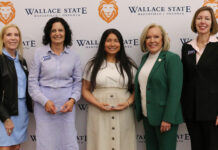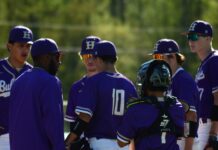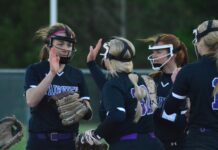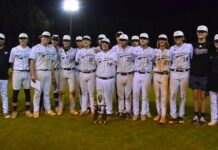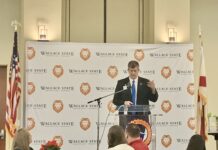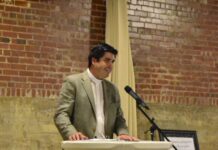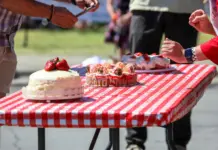Updated 7-15-20 at 3:11 p.m.
“I’m calling on everyone, everyone in our state, to practice personal responsibility and wear a mask. I continue to believe that personal responsibility is everyone’s responsibility.”- Gov. Kay Ivey
MONTGOMERY, Ala. – Citing increasing spread of COVID-19, along with record-high hospitalizations and decreasing ICU capacity across the state, Alabama Gov. Kay Ivey and State Health Officer Dr. Scott Harris on Wednesday announced a mandatory mask ordinance for the state of Alabama. The ordinance goes into effect Thursday, July 16 at 5 p.m. and is set to expire July 31.
“Here’s the bottom line,” said Ivey. “Overnight, last night, we had 2,141 new cases. That brings our total to 58,270 cases, and we’ve had 1,183 deaths. Over a two-week period, from June 29 to July 13, the total number of COVID-19 cases in Alabama rose by 50%. And the number of COVID patients hospitalized during this same time period has increased significantly. Nine of the first 13 days of July saw daily increases of more than 1,000 cases. Despite all our best efforts, we’re seeing increased cases every day still occurring, and we’re almost to the point where our hospital ICUs are overwhelmed. Earlier this week, 87% of our ICU beds statewide were occupied. Folks, the numbers just do not lie.”
According to the FAQ sheet on the new mask ordinance, “You have to wear a mask when you are in public and in close contact with other people. Specifically, the order says to wear a mask when you are within six feet of a person from another household in any of the following places: (a) an indoor space open to the public; (b) a vehicle operated by a transportation service; and (c) an outdoor public space where ten or more people are gathered.
“There are five categories of exceptions. The largest category, exceptions for “practical necessity,” covers people or situations where mask use is incompatible with the realities of life—for example, children six or younger, people with certain medical conditions or disabilities, eating and drinking, medical and dental procedures, and so on. There are also categories of exceptions for exercise, for communicating with an audience, and for certain essential job functions. An additional category carves out narrow exceptions for protected activities like voting and religious worship—but even then, wearing a mask is strongly encouraged.”
“I always prefer personal responsibility over a government mandate, and yet I also know, with all my heart, that the numbers and the data over the past few weeks are definitely trending in the wrong direction,” Ivey said.
Harris said one-third of Alabama’s COVID-19 cases were added in the last two weeks and that the state’s case fatality rate is about 2%.
“That’s not a reflection of testing,” he said, “because our percentage of tests that are positive continues to go up. The most recent complete data leading up to the 4th of July showed about 14% of all tests were positive. It’s still preliminary, but the numbers we’ll release for this past week are going to be between 16-17%.”
Said Ivey, “Throughout this process, I have said that I reserve the right to come back and reverse course. This mask mandate is the first step of doing just that. Clearly, there’s some other, more restrictive actions that we could take, such as closing things back down. But I don’t want to go there unless there are absolutely no other options available.”
Below is the specific wording from the amended Safer at Home Order:
2. Facial coverings for individuals. Effective July 16, 2020 at 5:00 P.M., each person shall wear a mask or other facial covering that covers his or her nostrils and mouth at all times when within six feet of a person from another household in any of the following places: an indoor space open to the general public, a vehicle operated by a transportation service, or an outdoor public space where ten or more people are gathered. But this facial-covering requirement is subject to the following exceptions.
a. Exceptions for practical necessity. The facial-covering requirement does not apply to:
(i)Any person six years of age or younger;
(ii)Any person with a medical condition or disability that prevents him or her from wearing a facial covering;
(iii)Any person while consuming food or drink, or seated at a restaurant to eat or drink;
(iv)Any person who is obtaining a service (for example, a medical or dental procedure) that requires removal of the facial covering in order to perform the service; or
(v)Any person who is required to remove the facial covering to confirm his or her identity, such as for security or screening purposes.
b. Exceptions for exercise. The facial-covering requirement does not apply to:
(i)Any person who is actively engaged in exercise in a gym or other athletic facility if he or she maintains six feet of separation from persons of another household;
(ii)Any person who is directly participating in athletic activities in compliance with paragraph 11 of this order; or
(iii)Any person who is in a swimming pool, lake, water attraction, or similar body of water, though wearing a face covering or social distancing is strongly encouraged if safe and practicable.
c. Exceptions for effective communication. The facial-covering requirement does not apply to:
(i)Any person who is seeking to communicate with another person where the ability to see the person’s mouth is essential for communication (such as when the other person has a hearing impairment); or
(ii)Any person speaking for broadcast or to an audience if the person maintains six feet of separation from persons from another household.
d. Exceptions to facilitate constitutionally protected activity. The facial-covering requirement does not apply to:
(i)Any person who is voting, though wearing a face covering is strongly encouraged; or
(ii)Any person who cannot wear a facial covering because he or she is actively providing or obtaining access to religious worship, though wearing a face covering is strongly encouraged.
e. Exceptions for essential job functions. The facial-covering requirement does not apply to:
(i) Any first responder (including law enforcement officers, firefighters, or emergency medical personnel) if necessary to perform a public-safety function; or
(ii) Any person performing a job function if wearing a face covering is inconsistent with industry safety standards or a business’s established safety protocols.
Masks or other facial coverings can be factory-made, homemade, or improvised from household items such as scarves, bandanas, or t-shirts. For instructions on how to make a facial covering at home, see the Centers for Disease Control and Prevention (CDC)’s “How to Make Cloth Face Coverings,” available at https://www.cdc.gov/coronavirus/2019-ncov/prevent-getting-sick/how-to-make-cloth-face-covering.html.
Copyright 2020 Humble Roots, LLC. All Rights Reserved.
2020 Health Order Update Ends July 31 Mask Requirement by TheCullmanTribune on Scribd
Coronavirus.MaskOrderFAQ by TheCullmanTribune on Scribd










